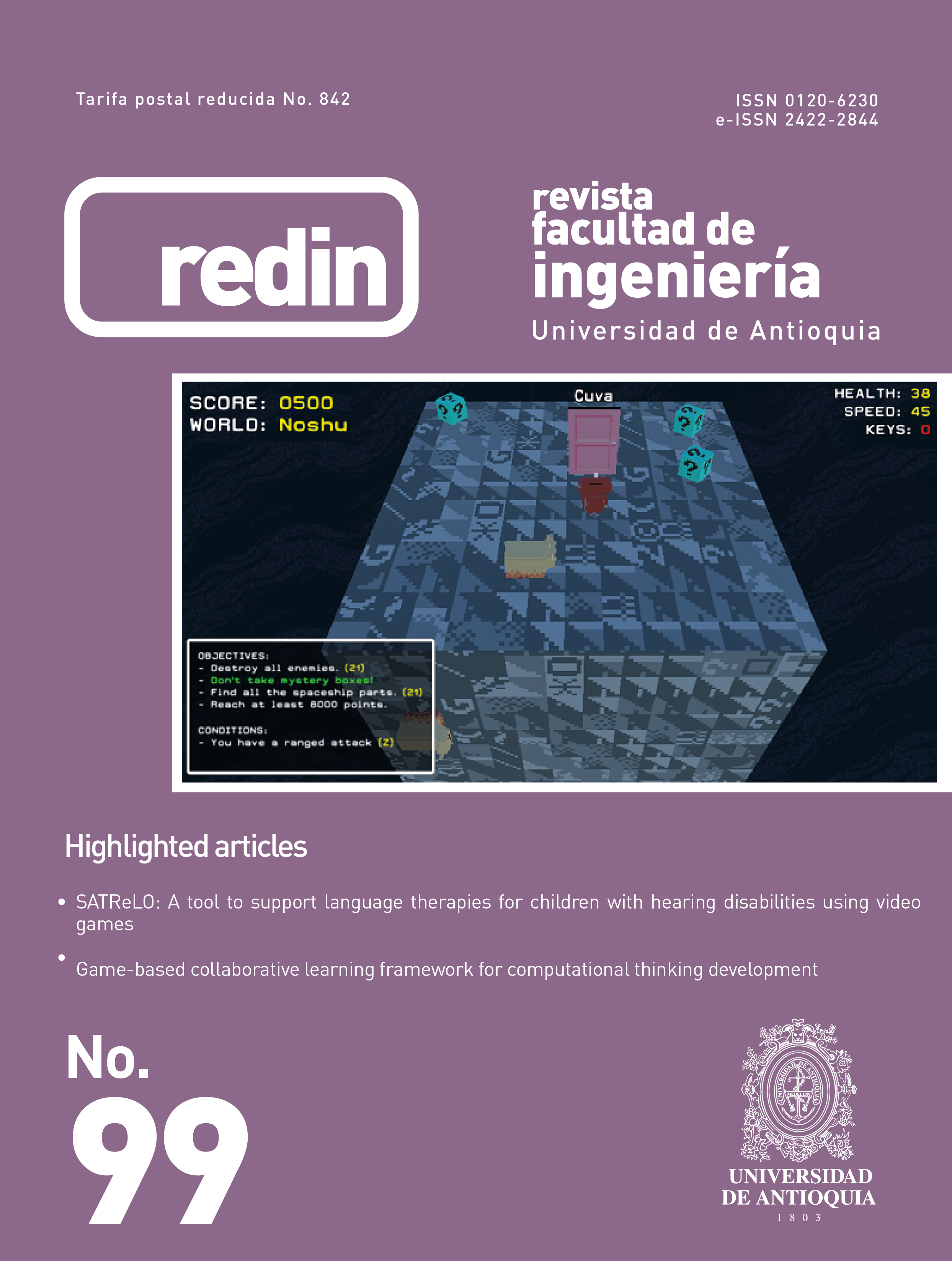Eficiencia de sistemas subterráneos de retención y reducción de inundaciones urbanas en Tepic, México
DOI:
https://doi.org/10.17533/udea.redin.20200585Palabras clave:
control, caudal, precipitaciones, SUDS , urbanizaciónResumen
Diversas ciudades de México han venido presentando recurrentes inundaciones ocasionadas por cambios en los usos del suelo, modificación de los escurrimientos superficiales y subterráneos, artificialización de las zonas destinadas inicialmente para la infiltración y recarga freática, y en general, insuficiencia y deficiencia de las redes locales de drenaje urbano que se vuelven incapaces de evacuar los excedentes anuales de precipitación. En este sentido, el objetivo de este estudio evalúa la eficiencia de un sistema subterráneo de detención de agua pluvial en una de las principales avenidas de la ciudad de Tepic, México: la Avenida Tecnológico. Para ello, se realiza un análisis de contenidos temáticos e inspección in situ auxiliados por sistemas de información geográfica, cuyos resultados muestran, desde un enfoque sistémico y la lógica de un modelo cualitativo, que la capacidad de las redes pluviales urbanas de evacuación de agua pluvial en el centro urbano está dimensionalmente rebasada y que la alternativa de sistemas de retención-detención pueden mitigar la entropía urbana generada por las inundaciones.
Descargas
Citas
M. A. Salas and M. Jiménez. (2004, Oct.) Inundaciones. CENAPRED. Ciudad de México, México. [Online]. Available: https://bit.ly/2XhMLOL
D. Rojas and M. G. González, “Incertidumbre en los modelos hidrológicos y planeación de obras hidráulicas en México,” Ingeniería Hidráulica y Ambiental , vol. 36, no. 2, pp. 69–83, May 2015.
J. Acosta, “Las inundaciones en la Argentina,” in Inundaciones en el Area Metropolitana de Buenos Aires , A. Kreimer, D. Kullock, and J. B. Valdes, Eds. Washington, USA: World Bank, 2000.
A. Maskrey, Los desastres no son naturales . Panama City, Republic of Panama: La Red, 1993.
N. Prudkin and D. D. Pietri, “Las inundaciones en el AMBA: Análisis ecológico,” in Inundaciones en el Area Metropolitana de Buenos Aires , A. Kreimer, D. Kullock, and J. B. Valdes, Eds. Washington, USA: World Bank, 2000, pp. 108–122.
D. F. Campos, Introducción a la hidrología urbana , 1st ed., San Luis Potosí, México, 2010.
A. Trapote and H. Fernández. (2016, Nov.) Técnicas de drenaje urbano sostenible. Instituto Universitario del Agua y de las Ciencias Ambientales. Alicante, España. [Online]. Available: https://bit.ly/2zQx0X5
Q. Zhou, “A review of sustainable urban drainage systems considering the climate change and urbanization impacts,” Water , vol. 6, no. 4, April 2014. [Online]. Available: https://doi.org/10.3390/w6040976
Preliminary data summary of urban storm water best management practices . Washington DC, EEUU: Environmental Protection Agency, 1999.
D. Castro, J. Rodriguez, J. Hernandez, and F. Ballester, “Sistemas urbanos de drenaje sostenible (SUDS),” Interciencia , vol. 30, no. 5, pp. 255–260, May 2005.
E. D. Cubides and G. E. Santos, “Control de escorrentías urbanas mediante sistemas urbanos de drenaje sostenible (SUDS): Pozos/zanjas de infiltración,” Entre Ciencia e Ingeniería , vol. 12, no. 24, December 2018. [Online]. Available: https://doi.org/10.31908/19098367.3813
C. O. Martínez, “Sistemas urbanos de drenaje sostenible SUDS: Infraestructura hidráulica urbana para el control y aprovechamiento del agua de lluvia,” Undergraduate, Universidad Nacional Autónoma de México, Ciudad de México, México, 2015.
The SuDS manual , CIRIA, London, England, 2007.
M. P. Molina, L. Gutiérrez, and J. Salazar, “Sistemas urbanos de drenaje sostenible SUDS para el plan de ordenamiento zonal norte POZN,” Secretaría Distrital de Ambiente, Bogotá, Colombia, Tech. Rep., Dec. 2011.
S. Perales and I. A. Doménech, “Los sistemas urbanos de drenaje sostenible: una alternativa a la gestión del agua de lluvia,” in IX Simposio de Hidrología Elche , Alicante, España, 2008, pp. 1–15.
[´¨´16] E. D. Cubides, “Control de escorrentías urbanas mediante pozos de infiltración: Aplicación práctica a un tramo del colector de aguas lluvias de la localidad de Fontibón Bogotá D.C.” M.S. thesis, Escuela Colombiana de Ingeniería Julio Garavito, Bogotá, Colombia, 2016.
M. G. González, “Entropy and negentropy of private electric vehicles in urban systems: Homeostasis of mobility in México,” DYNA , vol. 85, no. 206, July 2018. [Online]. Available: https://doi.org/10.15446/dyna.v85n206.72509
F. J. Aparicio, Fundamentos de hidrología de superficie . Ciudad de México, México: Limusa, 2010.
G. Sotelo, Hidráulica de canales . Ciudad de México, México: Universidad Nacional Autónoma de México, 2002.
A. Rocha, Hidráulica de tuberías y canales , 1st ed. Lima, Perú: Universidad Nacional de Ingeniería, 2007.
(2014, Feb.) Criterios y lineamientos técnicos para factibilidades en la A.M.G. SIAPA. Guadalajara, México. [Online]. Available: https://bit.ly/2zQgpCN
Descargas
Publicado
Cómo citar
Número
Sección
Licencia
Derechos de autor 2021 Revista Facultad de Ingeniería Universidad de Antioquia

Esta obra está bajo una licencia internacional Creative Commons Atribución-NoComercial-CompartirIgual 4.0.
Los artículos disponibles en la Revista Facultad de Ingeniería, Universidad de Antioquia están bajo la licencia Creative Commons Attribution BY-NC-SA 4.0.
Eres libre de:
Compartir — copiar y redistribuir el material en cualquier medio o formato
Adaptar : remezclar, transformar y construir sobre el material.
Bajo los siguientes términos:
Reconocimiento : debe otorgar el crédito correspondiente , proporcionar un enlace a la licencia e indicar si se realizaron cambios . Puede hacerlo de cualquier manera razonable, pero no de ninguna manera que sugiera que el licenciante lo respalda a usted o su uso.
No comercial : no puede utilizar el material con fines comerciales .
Compartir igual : si remezcla, transforma o construye a partir del material, debe distribuir sus contribuciones bajo la misma licencia que el original.
El material publicado por la revista puede ser distribuido, copiado y exhibido por terceros si se dan los respectivos créditos a la revista, sin ningún costo. No se puede obtener ningún beneficio comercial y las obras derivadas tienen que estar bajo los mismos términos de licencia que el trabajo original.










 Twitter
Twitter